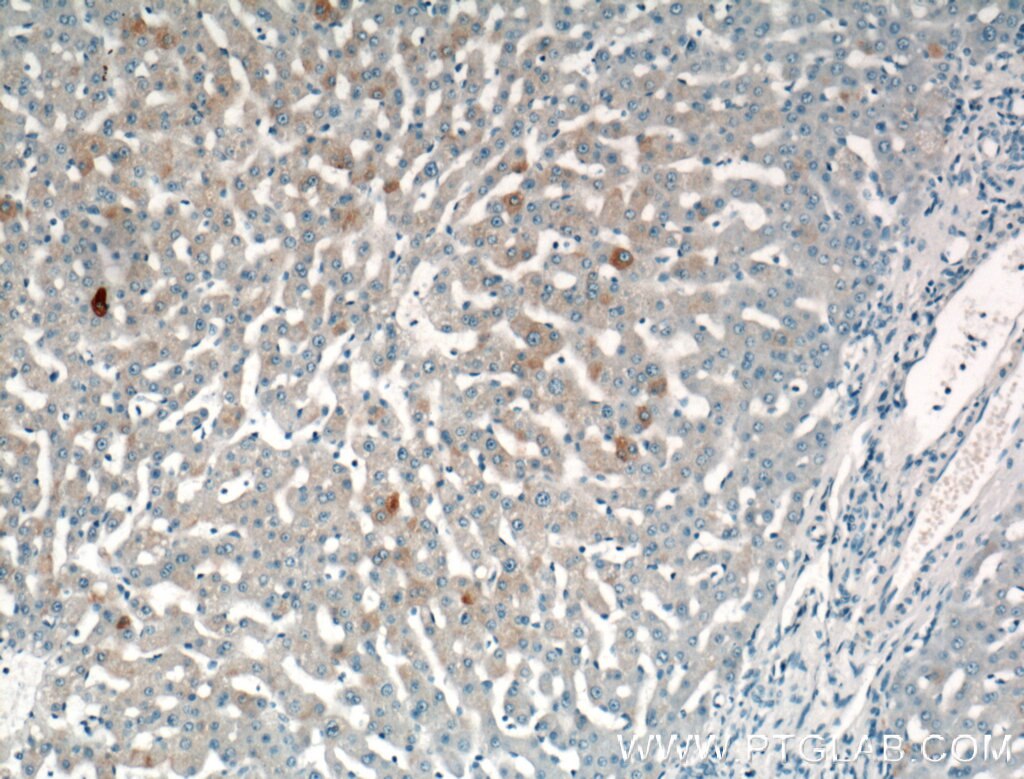- Featured Product
- KD/KO Validated
SPG11 Polyklonaler Antikörper
SPG11 Polyklonal Antikörper für IHC, ELISA
Wirt / Isotyp
Kaninchen / IgG
Getestete Reaktivität
human, Maus, Ratte
Anwendung
WB, IHC, CoIP, ELISA
Konjugation
Unkonjugiert
Kat-Nr. : 16555-1-AP
Synonyme
Geprüfte Anwendungen
| Erfolgreiche Detektion in IHC | humanes Lebergewebe Hinweis: Antigendemaskierung mit TE-Puffer pH 9,0 empfohlen. (*) Wahlweise kann die Antigendemaskierung auch mit Citratpuffer pH 6,0 erfolgen. |
Empfohlene Verdünnung
| Anwendung | Verdünnung |
|---|---|
| Immunhistochemie (IHC) | IHC : 1:50-1:500 |
| It is recommended that this reagent should be titrated in each testing system to obtain optimal results. | |
| Sample-dependent, check data in validation data gallery | |
Veröffentlichte Anwendungen
| KD/KO | See 2 publications below |
| WB | See 8 publications below |
| CoIP | See 1 publications below |
Produktinformation
16555-1-AP bindet in WB, IHC, CoIP, ELISA SPG11 und zeigt Reaktivität mit human, Maus, Ratten
| Getestete Reaktivität | human, Maus, Ratte |
| In Publikationen genannte Reaktivität | human, Maus |
| Wirt / Isotyp | Kaninchen / IgG |
| Klonalität | Polyklonal |
| Typ | Antikörper |
| Immunogen | SPG11 fusion protein Ag9769 |
| Vollständiger Name | spastic paraplegia 11 (autosomal recessive) |
| Berechnetes Molekulargewicht | 2443 aa, 279 kDa |
| GenBank-Zugangsnummer | BC024161 |
| Gene symbol | SPG11 |
| Gene ID (NCBI) | 80208 |
| Konjugation | Unkonjugiert |
| Form | Liquid |
| Reinigungsmethode | Antigen-Affinitätsreinigung |
| Lagerungspuffer | PBS with 0.02% sodium azide and 50% glycerol |
| Lagerungsbedingungen | Bei -20°C lagern. Nach dem Versand ein Jahr lang stabil Aliquotieren ist bei -20oC Lagerung nicht notwendig. 20ul Größen enthalten 0,1% BSA. |
Protokolle
| PRODUKTSPEZIFISCHE PROTOKOLLE | |
|---|---|
| IHC protocol for SPG11 antibody 16555-1-AP | Protokoll herunterladenl |
| STANDARD-PROTOKOLLE | |
|---|---|
| Klicken Sie hier, um unsere Standardprotokolle anzuzeigen |
Publikationen
| Species | Application | Title |
|---|---|---|
J Clin Invest Spastic paraplegia proteins spastizin and spatacsin mediate autophagic lysosome reformation. | ||
PLoS Genet A hereditary spastic paraplegia mouse model supports a role of ZFYVE26/SPASTIZIN for the endolysosomal system. | ||
Hum Mol Genet SPG15 protein deficits are at the crossroads between lysosomal abnormalities, altered lipid metabolism and synaptic dysfunction. | ||
Neurobiol Dis Loss of spatacsin function alters lysosomal lipid clearance leading to upper and lower motor neuron degeneration.
| ||
Ann Clin Transl Neurol Lysosomal abnormalities in hereditary spastic paraplegia types SPG15 and SPG11.
|



